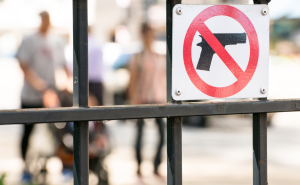Oregon’s Measure 114: Reducing Gun Violence by State Referendum

Gun deaths reached an all-time high in 2021 following unprecedented purchasing during the pandemic. Worse—these spikes are occurring as states and the Supreme Court roll back policies and provisions known to prevent gun violence.
But then there are the voters of Oregon who came together to pass Measure 114 at the recent midterm elections which puts permit-to-purchase laws in place and restricts magazine capacity on firearms.
In this Q&A, adapted from a bonus episode of Public Health On Call, Cass Crifasi, PhD ’14, MPH, co-director of the Johns Hopkins Center for Gun Violence Solutions, talks with Lindsay Smith Rogers about why this measure is a lifesaving win and how it fits into the larger conversation about gun policies in the U.S., and how the future of gun violence prevention could be in the hands of voters.
Public Health On Call
This article was adapted from the November 22 episode of Public Health On Call Podcast.
In the midterm elections, Oregon voters passed Measure 114. What is Measure 114?
Measure 114 was a ballot initiative that had two components. The first was a restriction on magazine capacity—the part of the firearm that takes the bullets—requiring that magazines hold 10 or fewer rounds. The second component was a “permit-to-purchase” (PTP) system. This would require prospective gun purchasers to first get a license, which includes a [requirement for a] background check and safety training.
The Center for Gun Violence Solutions formally endorsed this measure and helped advocate for it. Why?
We've been studying PTP laws for more than 10 years and conducted several studies examining the impact of these laws on various outcomes.
The body of research on PTP laws is pretty robust. It shows that these laws generally have substantial public safety benefits. When states put these laws into place, we see reductions in gun violence, and when states repeal these laws we see increases in violence.
Daniel Webster led a study that looked at fatal mass shootings and considered these PTP laws, and we saw some reductions in those outcomes. We also looked at large-capacity magazine bans in that study, and we found that states that regulate magazine capacity saw both a lower incidence of fatal mass shootings and fewer people injured if a fatal mass shooting did occur. Measure 114 pulled these two policies together.
Our team also used a tool we created called the Racial Equity Impact Assessment, which focuses specifically on gun policy. We wanted to assess whether this measure might exacerbate or mitigate existing disparities [and] whether there might be unintended consequences of putting this policy into place.
So, pulling all of these things together—our existing research and the equity impact assessment— we felt that this was a strong measure that could help save lives in Oregon, so we formally endorsed it.
It was really exciting. It's the first time we've done this [advocacy work] as a new center. We also shared data and information with our partners in Oregon, like fact sheets and information, and Daniel Webster participated in a media briefing. All of these activities together helped gain additional support from folks in Oregon and some large organizations came out in support, which we think was really impactful in getting this ballot initiative passed.
The initiative passed by just over 30,000 votes. I think at the last count it was like 49.1% to 50.9%. What does it say that this vote was so close?
There are a few things to consider. When we look at public opinion polling data on PTP laws, we regularly see upwards of 75% support among U.S. adults. We also see around 60% support among gun owners. But it's important to keep in mind that breadth of support—how many people support a thing—doesn't always translate into depth of support. So, people might think a policy is a good idea, but they might not be motivated enough or activated enough to take action to support it.
It's also important to remember that this ballot initiative had two different policies in it. There was a permit-to-purchase policy, but also the large-capacity magazine ban and restrictions on magazine capacity. That's one of the few policies we studied that usually doesn't achieve majority support. So, having those two pieces in one measure might have lowered support [than if] they had been independent.
This ballot initiative also came together really quickly. We were anticipating that this might be on the ballot in 2024, but in the wake of the Buffalo and Uvalde shootings, there was immense interest in doing something. And, because Oregon has the ballot initiative process, they were able to gather the signatures and get it on the ballot this year.
[Because] it came together quickly, maybe there wasn't the same amount of prep work to educate officials and the public on this topic. But, now that it's passed, we are very excited to work with the legislature to make sure it gets implemented effectively.
What's a timeframe where we might actually see some of these outcomes that you were talking about previously?
It's a really great question. Sometimes a ballot initiative says, when this passes, X amount of time has to happen, so you might not see it go into place for a year or two. This initiative said, as soon as it passes, the legislature needs to get to work and roll this out.
It's really important to keep in mind that when you pass new policies and put them into place, it's not like flipping a light switch. Guns are durable products, there are a lot of them out there, and we know that around 20% of gun sales occur through private markets that might not be regulated. We're not immediately going to see reductions [in gun violence].
But in work we've done in places like Connecticut, for example, we've seen 20 to 30% reductions in gun homicide and gun suicide in the 10 years following the passage of [permit-to-purchase laws]. Conversely, when states take their laws away, we actually see a much quicker impact: Within a few years, you can start to see those harmful effects.
We're going to be keeping an eye on this, evaluating what's happening over time in Oregon. And we have folks in our Center with expertise in implementation, in advocacy, who will be working to make sure policymakers have what they need to [ensure] that this law has the right regulations and procedures in place—not just for screening out prohibited individuals, but making sure that it's implemented equitably.
Where does Measure 114 fall into the context of the recent Supreme Court ruling, which struck down a New York law with restrictions on carrying firearms?
In very simple terms, the Bruen decision did two things: First, it struck down the “proper cause” requirement for concealed carry licensing. New York and seven other states had what we refer to as “may issue laws.” This means that applicants have to meet some strict background check criteria. They have training requirements. And then they also have to demonstrate a good and substantial reason to carry a concealed gun in public. There were concerns about how this [proper cause requirement] was being used—fairly or otherwise—so the Supreme Court struck that provision down.
The other piece of the Bruen decision, which is the more concerning piece, struck down the “two part test” that the courts had coalesced around post-Heller, the 2008 Supreme Court decision that struck down the Washington, D.C., handgun ban.
Now, in the wake of Bruen, courts are having to look at laws that were on the books at the time that the Second and 14th amendments were ratified—between around 1791 and the early 1800s—for relevant laws, or to find historical analogues. That's a concern, because for some of our most important policies, some things were not unlawful. I’m thinking about domestic violence prohibitions or provisions [and] even about large-capacity magazine bans. Many firearms that existed at that time had one shot. So in thinking about restricting capacity, it might be hard to come up with [historical] analogues, which might make it easier for folks to challenge laws and harder for courts to uphold them.
There is still an important role for public health data to advocate for what we need to see, to support effective policies, and to keep them in place. Many places in the U.S. have had permit-to-purchase laws for a very long time—more than 100 years in some states—so there are some historical precedents for these policies. All of that is to say, we are being mindful about what is valid and viable in the wake of Bruen.
This measure is a victory for gun policy, especially when it comes to solutions for gun violence. Could we see other states following suit?
Absolutely. Around half of U.S. states have some kind of ballot initiative process. In the absence of legislative action at the state level, voters in those states could pursue a ballot initiative.
We're working with partners in Delaware on PTP legislation, and it looks like things might be primed for this upcoming session starting in 2023. We're also looking at partnering with folks in Washington state to see whether they’re ready to implement a PTP law.
Any last thoughts?
I'm really excited about the success we've had with Measure 114. Not just because I think this is a strong evidence-based policy that will really be a lifesaving tool in Oregon, but also because it was one of the first times our newly formed Center has come together and done this effective translation [of research into advocacy].
For me, a core component of public health is taking the research and advocating for the changes that we know are going to save lives. We have some of the best gun violence prevention researchers in the country. We have some of the best advocates in the country coming together, taking the best available data and evidence, and turning it into something actionable, giving people concrete recommendations. It's exciting to see the changes now. This is not about 50 years from now—although I certainly hope these laws will still be in place doing good work—but right now we are seeing the changes that we know need to happen, and that is really inspiring for me.
Lindsay Smith Rogers, MA, is the producer of the Public Health On Call podcast and the associate director of content strategy for the Johns Hopkins Bloomberg School of Public Health.
RELATED:
- New Report Highlights U.S. 2020 Gun-Related Deaths: Highest Number Ever Recorded by CDC, Gun Homicides Increase by More Than One-Third
- A Brief History of Guns in the U.S.
- Study Finds Significant Increase in Firearm Assaults in States that Relaxed Conceal Carry Permit Restrictions
- New Survey Finds Broad Public Support For Policies Regulating Carrying Guns in Public in the U.S.




